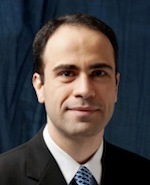Collaboration yields new methods to treat tumors with antennas
A conversation with a University of Wisconsin–Madison neurosurgeon prompted two engineering researchers to challenge a commonly held idea about tumor ablation, and as a result, they’re now working to commercialize a new technology that could yield less invasive radiation therapies for cancer patients.
Current microwave ablation systems essentially “cook” cancerous tumors. Surgeons insert an antenna into tissue to deliver electromagnetic energy, which heats up and kills the malignant cells. However, these antennas must be relatively large in size in order to produce the low-frequency radiation believed to be necessary for effective ablation treatments.

Joshua Medow
Joshua Medow, an assistant professor of neurosurgery, developed an interest in finding new ways to treat brain tumors after watching one of his instructors, UW–Madison neurosurgeon John A. Sandin, battle a brain tumor of his own. Sandin died in 2008, but Medow remained inspired by him. “When I was talking with John, I thought there has to be a better way (to treat brain tumors) than taking somebody’s head apart,” Medow says.
So Medow asked Susan Hagness and Nader Behdad, professor and associate professor of electrical and computer engineering, if they might be able to develop a different approach to thermal therapies.
Hagness and Behdad were familiar with the argument that ablation systems had to use relatively low-frequency microwave radiation in order to penetrate deep into human tissue and create a large enough ablation zone. But they were intrigued enough by their initial conversations with Medow to take a closer look at the potential for ablation systems that could operate at higher frequencies.
The two ran simulations to learn more about the limitations of higher frequency microwave ablation — and contrary to popular belief, they discovered that high-frequency microwaves could in fact offer a comparable ablation zone to existing low-frequency antennas.

Susan Hagness
Now, with a $390,000 grant from the National Science Foundation (NSF), technology accelerator funding from the Wisconsin Alumni Research Foundation (WARF) and licensing support, the three are using these initial findings to design smaller ablation antennas that can reach tumor sites through less invasive methods.
“Sometimes surgeons need to treat a tumor where the direct line of sight from the surface of the body would route you through healthy tissue that you wouldn’t want to stick a needle through,” Hagness says. “So if we can design the antenna to be small enough to route around bends, we open up a whole new realm of treatment possibilities.”
Hagness, Behdad and graduate student Hung Luyen discovered that in addition to making shorter antennas, they could also make narrower ones by eliminating a bulky component called a balun, which controls the flow of current and converts balanced signals to unbalanced signals. The team found that operating antennas at a different resonant frequency creates a natural chokepoint that can control current without a balun.
These miniaturized antennas could allow surgeons to get an antenna to a tumor site by routing a catheter through a patient’s circulatory system, which is far less invasive than delivering the ablation probe through open surgery or laparoscopic surgery. Additionally, surgeons could use arrays of small antennas to customize ablation treatments for specific cancers and patient needs.

Nader Behdad
The researchers say these advances especially could enable a leap ahead in the treatment of brain tumors, and routing an antenna in via blood vessels or a small hole drilled in the skull could greatly improve a patient’s quality of life and allow for more precisely targeted ablation therapies.
The NSF grant will give the team three years to investigate other novel antenna designs and flesh out the basic physics of high-frequency microwave tumor ablation. They’ll also continue moving their new antenna design, which has been patented through WARF, toward commercialization.
Subscribe to Wisconsin Ideas
Want more stories of the Wisconsin Idea in action? Sign-up for our monthly e-newsletter highlighting how Badgers are taking their education and research beyond the boundaries of the classroom to improve lives.



